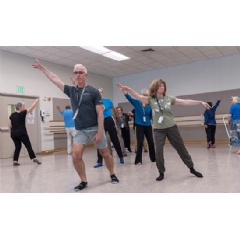Ballet as a Respite from Parkinson’s Disease
Kaiser Permanente supports the San Francisco Ballet in bringing regular dance-inspired movement classes to people with Parkinson’s disease.
Four days a week, Richard, 72, takes an express bus from his home in San Francisco’s Richmond District to his downtown job as a bank teller. There, he’s on his feet for 5 hours.
Richard’s routine would be impressive for any senior. But it is especially so for someone now 3 years in to a Parkinson’s disease diagnosis.
Then there are his Saturdays — spent taking a dance movement class sponsored by Kaiser Permanente at the San Francisco Ballet school.
Ballet is beneficial
Parkinson’s disease affects the nerve cells in the brain that produce dopamine. Symptoms include changes in speech and gait, fatigue, and balance issues — all symptoms Richard suffers — as well as muscle rigidity and tremors. Approximately half a million Americans have the disease. There is no cure, but treatments can help relieve symptoms.
That is what motivated the dance school’s director, Patrick Armand. His mother was the director of the Ballet National de Marseille in France. She received a very early diagnosis of the disease that eventually included dementia. Armand watched his mother’s long, painful decline, and it made an imprint.
“There is something I can do now for those with Parkinson’s that I couldn’t do then for her,” he said. “Ballet can be concretely beneficial. It’s a fantastic way for people to keep moving — an hour where they can just get away from everything and concentrate on their bodies.”
“Certain types of exercise and certain types of dance slow the progression of Parkinson’s symptoms,” added Meaghan Lynch, MD, a Kaiser Permanente physical medicine and rehabilitation physician and former ballet dancer. “Ballet — with its musicality, broad expansive movements, and poise — really lends itself to helping balance, gait stability, and mobility in these individuals.”
Dr. Lynch and Rima Ash, MD, a movement disorder neurologist, collaborated on the class structure with Cecelia Beam, a longtime San Francisco Ballet employee and dance instructor. Beam modelled the class after those developed by the Mark Morris Dance Group and Brooklyn Parkinson Group, and brought in her own love of folkloric dance.
Two years ago, 12 people took the first class. By now, about 75 have participated.
Richard was prepared to not like the class. He was already enjoying “rock steady” boxing elsewhere. But he changed his mind quickly.
“By the time the very first class was ending, I said, ‘You know what? I’m going to be back here next week. There’s something different about this.’”
Let’s dance some ‘Nutcracker’
In a large, sunny studio at the downtown ballet school, a pianist plays as we lift our arms and move our legs, emulating Beam’s slow and graceful movements. She is a wonderful, patient teacher who has said she finds leading this class “hugely gratifying.”
A visitor is readily welcomed and soon we are sliding and high-stepping our feet. We count and add in arm movements. Some participants hold on to the ballet barre. There are dances with partners, with leaders to follow, and a snaking dance for all.
About 30 people join Beam today, some from the safety of their seats if the disease is advanced or helped by family members, caregivers, or volunteers. While the dancing often prompts laughter, it is also clearly intended to loosen limbs, stretch bodies, and promote balance. Since Parkinson’s can weakens one’s voice, everyone joins in singing a Shaker folk song.
We do a seated version of the Russian Dance from “The Nutcracker,” folding our arms in front of our chests and tapping our toes out in front and to the side. Across the room, retired psychiatrist Reza, 80, smiles joyfully.
His days are full — playing with his 3-year-old granddaughter, reading in multiple languages while learning French, writing a blog, and going to boxing along with Richard, but he rarely misses the class that he said leaves him relaxed but not tired. “I have Parkinson’s, but I am not handicapped.”
Rebecca is a veteran journalist in her 60s who attends class for both the exercise and her many friendships.
She describes dance as having “a transcendent quality” that takes her somewhere else — reasons why she keeps coming. “If this class was every day, I would take it every day.”
Visit the San Francisco Ballet website for upcoming classes free to anyone in the community with Parkinson’s disease. Note: Participants are asked to commit to 8 classes. The deadline for classes starting on January 12, 2019, is December 30, 2018.
( Press Release Image: https://photos.webwire.com/prmedia/6/233532/233532-1.jpg )
WebWireID233532
This news content was configured by WebWire editorial staff. Linking is permitted.
News Release Distribution and Press Release Distribution Services Provided by WebWire.
